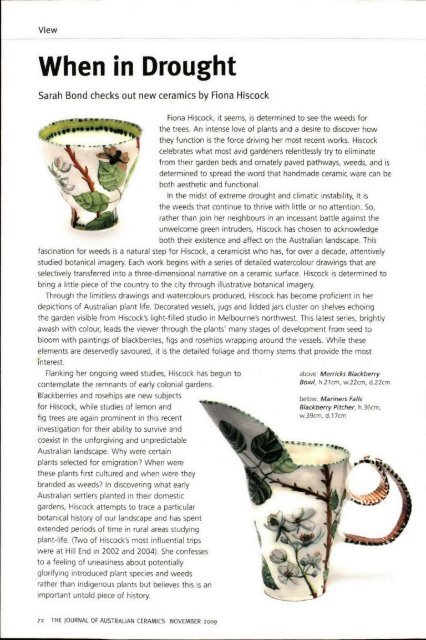The Journal of Australian Ceramics Vol 48 No 3 November 2009
Create successful ePaper yourself
Turn your PDF publications into a flip-book with our unique Google optimized e-Paper software.
View<br />
When in Drought<br />
Sarah Bond checks out new ceramics by Fiona Hiscock<br />
Fiona Hiscock, it seems, is determined to see the weeds for<br />
the trees. An intense love <strong>of</strong> plants and a desire to discover how<br />
they function is the force driving her most recent works. Hiscock<br />
celebrates what most avid gardeners relentlessly try to eliminate<br />
from their garden beds and ornately paved pathways, weeds, and is<br />
determined to spread the word that handmade ceramic ware can be<br />
both aesthetic and functional.<br />
In the midst <strong>of</strong> extreme drought and climatic instability, it is<br />
the weeds that continue to thrive with little or no attention. 50,<br />
rather than join her neighbours in an incessant battle against the<br />
unwelcome green intruders, Hiscock has chosen to acknowledge<br />
both their existence and affect on the <strong>Australian</strong> landscape. This<br />
fascination for weeds is a natural step for Hiscock, a ceramicist who has, for over a decade, attentively<br />
studied botanical imagery. Each work begins with a series <strong>of</strong> detailed watercolour drawings that are<br />
selectively transferred into a three-dimensional narrative on a ceramic surface. Hiscock is determined to<br />
bring a little piece <strong>of</strong> the country to the city through illustrative botanical imagery.<br />
Through the limitless drawings and watercolours produced, Hiscock has become pr<strong>of</strong>icient in her<br />
depictions <strong>of</strong> Austra lian plant life. Decorated vessels, jugs and lidded jars cluster on shelves echoing<br />
the garden visible from Hiscock's light-filled studio in Melbourne's northwest. This latest series, brightly<br />
awash with colour, leads the viewer through the plants' many stages <strong>of</strong> development from seed to<br />
bloom with paintings <strong>of</strong> blackberries, figs and rosehips wrapping around the vessels. While these<br />
elements are deservedly savoured, it is the detailed foliage and thorny stems that provide the most<br />
interest.<br />
Flanking her ongoing weed studies, Hiscock has begun to<br />
contemplate the remnants <strong>of</strong> early colonial gardens.<br />
Blackberries and rosehips are new subjects<br />
for Hiscock, while studies <strong>of</strong> lemon and<br />
fig trees are again prominent in this recent<br />
investigation for their ability to survive and<br />
coexist in the unforgiving and unpredictable<br />
<strong>Australian</strong> landscape. Why were certain<br />
plants selected for emigration? When were<br />
these plants first cultured and when were they<br />
branded as weeds? In discovering what early<br />
<strong>Australian</strong> settlers planted in their domestic<br />
gardens, Hiscock attempts to trace a particular<br />
botanical history <strong>of</strong> our landscape and has spent<br />
extended periods <strong>of</strong> time in rural areas studying<br />
plant-life. (Two <strong>of</strong> Hiscock's most influential trips<br />
were at Hill End in 2002 and 2004). 5he confesses<br />
to a feeling <strong>of</strong> uneasiness about potentially<br />
glorifying introduced plant species and weeds<br />
rather than indigenous plants but believes this is an<br />
important untold piece <strong>of</strong> history.<br />
above: Merricks Blackberry<br />
Bowl, h.2lem, w.22em, d.22cm<br />
below: Ma riners Falls<br />
Blackberry Pitcher, h.36em,<br />
w.39cm, d.17em<br />
72 THE JOURNAL OF AUSTRALIAN CERAMICS NOVEMBER <strong>2009</strong>


















